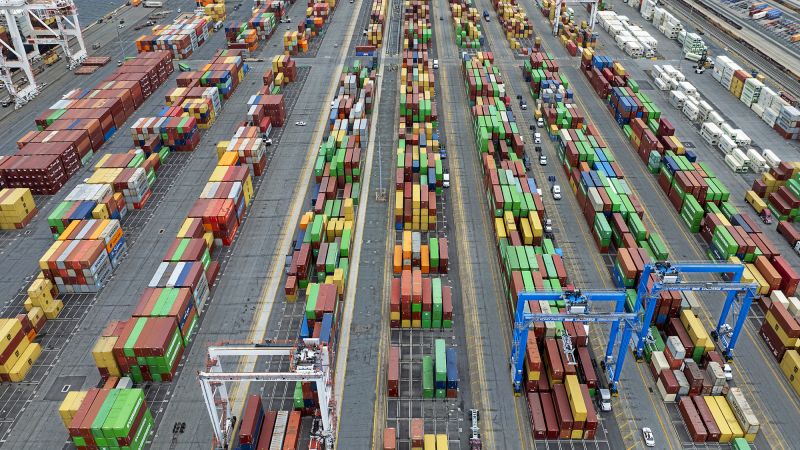A version of this story appeared in CNN Business’ Nightcap newsletter. To get it in your inbox, sign up for free here.
New York
CNN
—
The president doesn’t control the economy, right? Every election year, that’s the reminder voters get from historians, politicos, journalists and academics of all stripes. It’s practically a cliché — voters make choices based on gas prices and grocery bills, even though those things are largely out of any one politician’s control.
The political adage isn’t wrong, per se. It is, in fact, difficult for a single president to drastically improve the economy writ large.
But President Donald Trump is proving that a politician can absolutely harm the economy when they lack any regard for the consequences, borne largely by the people who elected them.
Tuesday marks the 100th day of Trump’s second term. In those 14 weeks, the president has unleashed an economic agenda so punishing that the only way to understand it in a historical context is not through a lens of policy but of plagues. If the Trump tariffs remain in place, the negative shocks could eclipse the the economic impact of the Covid-19 pandemic.
While Trump campaigned on a pledge to “immediately bring down prices, starting on Day One,” the White House has made scant progress on that promise beyond a broad executive order demanding federal agencies “deliver emergency price relief.”
Trump’s only major economic initiative, a sweeping tariff agenda, amounts to a massive tax increase on American consumers. And it has landed the US at the lonely center of a global trade war — the sole aggressor, lobbing tax bombs at friends and foes alike.
The “sell America” trade — in which global investors yank their money out of US assets like the dollar and Treasuries, worried about the country’s stability — was practically unheard of before Trump’s second term. But over the past month, it has helped wipe out trillions in market value.
Despite Trump’s tariffs, the US economy remains, by some key metrics, in good shape — unemployment is low and inflation has cooled to around 2.5% this year from a pandemic-era peak of 9.1% in 2022. Of course, unemployment was low and inflation was falling under the Biden administration, too.
Economists say gauging the impact of Trump’s tariffs, at least in the near term, will be difficult, in part because consumers have been shopping more to try to get ahead of price increases. That rush of spending may not last.
But longer term, the chances of a recession, according to virtually every economic forecaster, are higher now than they were 100 days ago. Estimates vary between a coin flip and 70%. Prediction market Kalshi currently puts the likelihood of a US recession at 57%.
Businesses are paralyzed, unsure whether to believe that Trump’s on-again, off-again tariffs will stay in place. Consumer confidence — which had held strong even under generationally high inflation during Biden’s term — is wavering.
Absent from Trump’s tariff plan is anything that would immediately address the cost-of-living pain that voters overwhelmingly cited as their reason for re-electing him.
Much of the public is now angry. A new CNN poll conducted by SSRS found that 59% of the country now believes Trump’s policies have worsened economic conditions, up from 51% in March.
Tariffs, in particular, are not going over well. Price increases are already being felt, with 60% of US adults saying Trump’s policies have increased the cost of living in their community. Just 12% said Trump’s agenda has helped to bring prices down.
The CNN polling tracks with other readings of the national mood. Consumer sentiment in April hit its fourth-lowest level on records going back to 1952, according to a closely watched University of Michigan survey. Inflation expectations reached their highest level since 1981.
While that kind of polling isn’t the kind of “hard data” policymakers typically rely on, the way people feel about the economy matters, especially when it comes to prices. When people expect the economy to sour, they tend to pull back on spending, which slows economic growth.
Right now, nearly 70% of Americans think it’s at least somewhat likely the US will go into a recession in the next year, according to the CNN poll.
We can see that caution already playing out: Airlines are cutting flights ahead of the summer travel season as fewer people plan trips. Companies are lowering or altogether scrapping their earnings guidance, citing uncertainty around tariffs.
Shipments carrying goods from China to the US are expected to fall dramatically in the coming days. According to Ryan Petersen, CEO of logistics conglomerate Flexport, ocean container bookings from China to the United States were down more than 60% industry-wide in the three weeks since the US’s 145% tariffs on Chinese imports took effect.
Trump’s “Liberation Day” speech on April 2 promised a renaissance of American manufacturing that few outside the MAGA faithful believe is possible, or even preferable. But Trump offered one prediction that day that turned out to be truer than he could have imagined.
“This will be an entirely different country in a short period of time,” he said. “It’ll be something, the whole world will be talking about it.”

